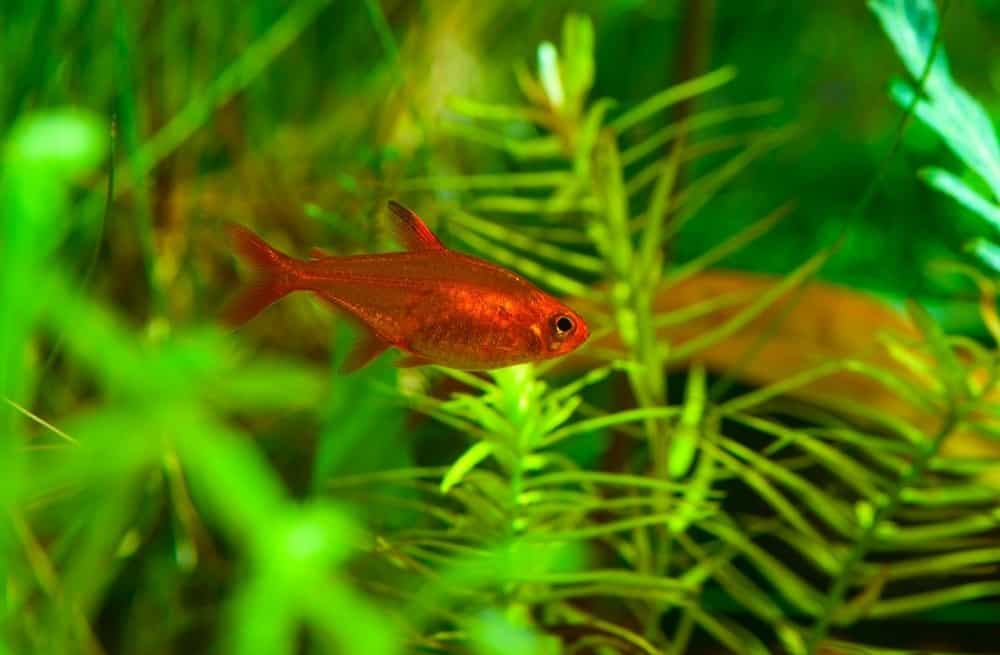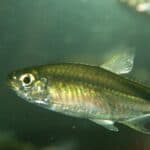It’s easy to see why Ember Tetras are becoming increasingly popular additions to tanks for many aquarists. Not only are they visually appealing, but they’re non-aggressive, playful, and easy to take care of. What’s not to love?
Let’s find out more about these adorable fish, and how to properly take care of them.

Species Summary
You can find Ember Tetras (or Hyphessobrycon amandae) most commonly in Central Brazil in the Araguaia River basin. They like to live in backwater rivers with low currents and plenty of vegetation, and this is why replicating that environment with lots of plants is important.
In the wild Ember Tetras eat a mixture of plants as well as tiny invertebrates. Their peaceful nature makes them very appealing to have in a busy tank, as they get along with a wide variety of tank mates.
But their appearance is a big part of what makes them so appealing. They possess a bright orange color which makes them stand out in freshwater nano aquariums.
Care Guide
Tank size: The ideal tank size for Ember Tetras is at least 10 gallons. This not only lets you keep a large group together, but gives you enough room for the plants they need to be surrounded by.
However, if you want to keep a large group of Ember Tetra together (for example, 20+) then you will need a tank size of 20 or 25 gallons.
Tank mates: Their gentle nature means that you can pair Ember Tetra with plenty of tank makes. Despite being active fish, Ember Tetra tend to keep to themselves and won’t bother their other tank mates.
However, you should keep in mind when choosing tank mates that Ember Tetra are middle-dwellers and won’t visit the top of the tank very often. This is good to know when picking tank mats for the Ember Tetra, so the different species can give each other space.
You should also avoid tank mates that are significantly larger than the Ember Tetra because they may become an unwitting snack for that bigger fish! The ideal tank mate for an Ember Tetra is a fish of similar size that isn’t aggressive, such as Cory Catfish, Neon Tetra, Pygmy Catfish, and Rasbora. For non-fish tank mates, opt for Cherry Shrimps or Nerite Snails.
Same species tanks: Although you can keep Ember Tetra in a single species tank, they need social interaction and thrive in diverse communities.
Water parameters: It’s not hard to maintain the proper water parameters for Ember Tetra. Their low-maintenance care needs is yet another thing that makes them so appealing!
Their ideal water temperature is anywhere between 73°F to 84°F, while 5-7 is the recommended pH level. Their ideal water hardness is 5-17 dGH, and of course it’s recommended to get an aquarium test kit and perform regular level tests once or twice a week.
What to put in their tanks: Plants! And lots of them. In their natural habitat, Ember Tetra are surrounded by an abundance of vegetation. This not only keeps the Ember Tetra healthy and comfortable, but does wonders for the water quality as well. The best plants to include are plants like Anachris, Hornwort, and Java Moss.
While plants are important, you don’t want the tank to be crowded. There should be enough room for the Ember Tetra to swim freely and interact with each other. They’ll use the plants as a place to hide and rest.
Common diseases: Ember Tetra are naturally hardy fish, so there aren’t a lot of diseases specific to the species that could harm them. However, poor diet and poor water quality can lead to infection and ill health in general.
Food & Diet: The Ember Tetra needs a healthy diet to keep them healthy and living for a long time. You’ll need to keep their diet varied to ensure they’re getting all the vitamins and nutrients they require.
This is best achieved with a mixed diet of flake fish food and frozen or freeze-dried food. For live food, Daphnia and brine shrimp is recommended as these are a great source of protein and nutrients.
They also occasionally snack on plants, so don’t worry if you spot your Ember Tetra doing this. They won’t eat enough to damage the plant, and this is completely normal behavior.
You can feed Ember Tetra 2-4 times a day, but it’s also important to avoid overfeeding. Because they’re so small, it’s easy to give them more food than is necessary and this can lead to health problems down the line. Always keep an eye on your fish for signs of malaise.
Lifespan
Ember Tetra can live between 2 to 4 years, and while some sources have reported them living up to 10 years this is considered to be inaccurate.
Their longevity is dependent on how well you care for them and the habitat they live in. Besides water quality, the presence of plants has a huge influence on how long they will live. Ember Tetra that live in tanks with plenty of plants tend to live much longer than ones who don’t.
Appearance
As we’ve already mentioned, the appearance of Ember Tetra is what makes them so popular among aquarists. They’re beautiful fish with a bright, mesmerizing coloration that makes them a delight to watch swim around the tank.
They have an orange-red tone that gives them a bright hue all over. It’s hard not to spot an Ember Tetra!
They have tall and thin dorsal fins with a gradient that fades from their primary color to a slightly darker tone at the back. This darker area becomes almost transparent at the tip of the fin.
Meanwhile their caudal fins are forked and have a more severe color transition than their dorsal fins. The very base of the fin blends in with the rest of their bodies, or can sometimes be brighter, but then it soon transitions into a darker orange before becoming almost completely transparent.
The clear part of their caudal fin makes up the back half of the fin.
Their ventral and pectoral fins are almost completely transparent too, and what makes these fins particularly cool is the little flicker they make while the Ember Tetra are swimming.
Their bodies have the same build as other species of Tetra. That is, they are thicker and taller in their front half but become thinner behind their dorsal fins.
Size
The average size for an Ember Tetra is just under 1 inch in length. This makes them slightly smaller than another popular Tetra, the Neon Tetra. This sets the two fishes apart, as a lot of people mistake them for the same fish, just with a different coloration.
While there have been incidents where an Ember Tetra has grown larger than an inch, this is rare. The size of these fish is often not visibly impacted by the quality of their care.
Behavior and Temperament
Ember Tetra are a delight to have in your tank, thanks to their general temperament and behavioral tendencies. What sets them apart from most fish species is just how active they are.
They are shoaling fish so you’ll almost always see them in a group, and because of their bright colors watching them swim around is a real treat – they look like a group of orange bullets whizzing around the tank!
They’re also curious fish and as a group they will explore different areas of the tank. They’re also brave fish, not afraid to check out the similarly sized tank mates.
Still, they do like spending most of their time secluded in the surrounding plants. This is their safe space and if they’re hanging out there that means they usually want some rest.
They’re also not aggressive, which again makes them great for a diverse tank. In fact, we would call them ideal tank mates!
Breeding
Unlike some fish, Ember Tetra are easy to breed and for breeders, it’s quite a low-maintenance process.
To get started, you just need a tank that houses males and females and adjust the water to reach a pH of around 7. You also need to keep the temperature on the higher side of their normal range (so at least above 80°F). These conditions will help encourage the spawning process.
Once spawning has happened the parents will leave the fry to fend for themselves. You should move them to a fry tank so you can help to grow before moving them to their own normal-sized tank.
Gender Difference: Male vs Female
Generally, female Ember Tetra are bigger than the males with plumper bodies. Males are also more colorful than the female fish.
Fun Facts
- Nicknames for the Ember Tetra are Amanda’s Tetra, Dwarf Tetra, and Fire Tetra.
- The Ember Tetra was first discovered in 1987 in the Araguaia River. Despite now being known as Ember Tetra they were originally named for the ichthyologist Heiko Bleher’s mother, Amanda. However, Bleher did not discover the species. But he still worked extensively with other fish species in South America.








